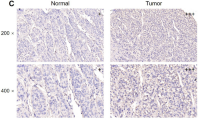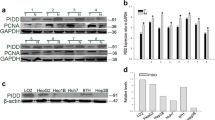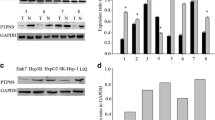Abstract
PIG11 (p53-induced gene 11) is a p53 target gene and candidate tumour suppressor gene. In this study, the expression of PIG11 protein was detected in human hepatocellular carcinoma (HCC) and normal liver tissues with an immunohistochemical method. Compared with expression in human normal liver tissues, the expression of PIG11 protein was significantly down-regulated in human HCC tissues. In addition, a recombinant pLXSN-PIG11 retroviral vector was constructed and transfected into HepG2 cells (human hepatocellular carcinoma cell line) and the role of PIG11 in apoptosis was analyzed. The percentage (18.60%) of apoptotic cells transfected with pLXSN-PIG11 was higher than that in cells transfected with pLXSN only (6.03%) or the vehicle control (3.81%) (P < 0.01). DNA gel electrophoresis showed a clear DNA ladder in pLXSN-PIG11-infected HepG2 cells. Our results suggested that the PIG11 gene is involved in carcinogenesis and development of hepatocarcinoma. Therefore, PIG11 is considered to be a new candidate liver tumour suppressor gene, and may play an important role in tumour suppression through promotion of cell apoptosis.



Similar content being viewed by others
References
Polyak K, Xia Y, Zweier JL et al (1997) A model for p53-induced apoptosis. Nature 389:300–305
Zhu J, Jiang J, Zhou W et al (1999) Differential regulation of cellular target genes by p53 devoid of the PXXP motifs with impaired apoptotic activity. Oncogene 18:2149–2155
Woo SH, Park IC, Park MJ et al (2002) Arsenic trioxide induces apoptosis through a reactive oxygen spcies-dependent pathway and loss of mitochondrial menbrane potential in Hele cells. Int J Oncol 21:57–63
Ramachandran C, Rodriguez S, Ramachandran R et al (2005) Expression profiles of apoptotic genes induced by curcumin in human breast cancer and mammary epithelial cell lines. Anticancer Res 25(5):3293–3302
Chiba T, Yokosuka O, Fukai K et al (2004) Cell growth inhibition and gene expression induced by the histone deacetylase inhibitor, trichostatin A, on human hepatoma cells. Oncology 66(6):481–491
Liang XQ, Cao EH, Zhang Y et al (2003) p53-induced gene 11 (PIG11) involved in arsenic trioxide induced apoptosis in human gastric cancer MGC-803 cells. Oncology Reports 10(5):1265–1269
Xiong X, Li H, Cao EH (2007) PIG11 protein binds to DNA in sequence-independent manner in vitro. BBRC 358:29–34
Liang XQ, Cao EH, Zhang Y et al (2004) A p53 target gene, PIG11, contributes to chemosensitivity of cells to arsenic trioxide. FEBS Letters 569(1–3):94–98
Ricketts SL, Carter JC, Coleman WB (2003) Identification of three 11p11.2 candidate liver tumor suppressors through analysis of known human genes. Mol Carcinog 36(2):90–99
Xu L, Hui AY, Albanis E et al (2005) Human hepatic stellate cell lines, LX-1 and LX-2: new tools for analysis of hepatic fibrosis. Gut 54:142–151
Chiba T, Yokosuka O, Fukai K et al (2004) Cell growth inhibition and gene expression induced by the histone deacetylase inhibitor, trichostatin A, on human hepatoma cells. Oncology 66:481–491
Song H, Xu Y (2007) Gain of function of p53 cancer mutants in disrupting critical DNA damage response pathways. Cell Cycle 6(13):1570–1573
Leder A, McMenamin J, Zhou F et al (2008) Genome-wide SNP analysis of Tg.AC transgenic mice reveals an oncogenic collaboration between v-Ha-ras and Ink4a, which is absent in p53 deficiency. Oncogene 27(17):2456–2465
Feng W, Xiao J, Zhang Z et al (2007) Senescence and apoptosis in carcinogenesis of cervical squamous carcinoma. Mod Pathol 20(9):961–966
Liu L, Qing S, Chen H et al (2000) An experimental study on arsenic trioxide-selectively induced human hepatocarcinoma cell lines apoptosis and its related genes. Zhonghua Gan Zang Bing Za Zhi 8(6):367–371 (Chinese)
Rivera A, Maxwell SA (2005) The p53-induced gene-6 (proline oxidase) mediates apoptosis through a calcineurin-dependent pathway. J Biol Chem 280:29346–29354
Ding WX, Shen HM, Ong CN et al (2000) Critical role of reactive oxygen species and mitochondrial permeability transition in microcystin-induced rapid apoptosis in rat hepatocytes. Hepatology 32(3):547–555
Touyz RM (2005) Reactive oxygen species as mediators of calcium signaling by angiotensin II:implications in vascular physiology and pathophysiology. Antioxid Redox Signal 7(9–10):1302–1314
Kim HJ, Chakravarti N, Oridate N et al (2006) N-(4-Hydroxyphenyl) retinamide-induced apoptosis triggered by reactive oxygen species is mediated by activation of MAPKs in head and neck squamous carcinoma cells. Oncogene 25(19):2785–2794
Acknowledgements
This work was supported by Hunan Provincial Natural Science Foundation of China (06JJ2048). Project supported by a grand (30570461) from National Science Foundation of China.
Author information
Authors and Affiliations
Corresponding author
Rights and permissions
About this article
Cite this article
Wu, Y., Liu, XM., Wang, XJ. et al. PIG11 is Involved in Hepatocellular Carcinogenesis and Its Over-expression Promotes Hepg2 Cell Apoptosis. Pathol. Oncol. Res. 15, 411–416 (2009). https://doi.org/10.1007/s12253-008-9138-5
Received:
Accepted:
Published:
Issue Date:
DOI: https://doi.org/10.1007/s12253-008-9138-5




